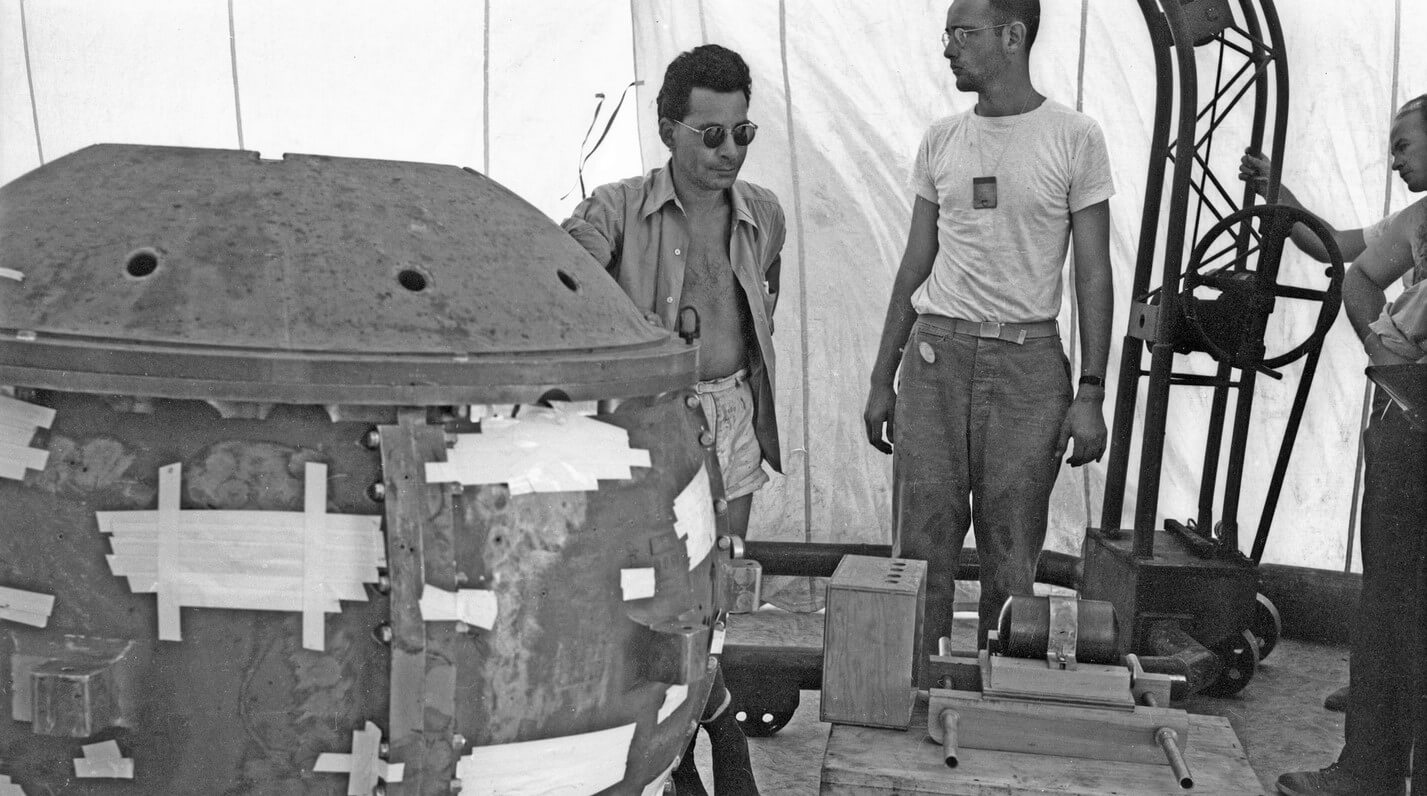Something Christoper Nolan didn’t show in Oppenheimer? Louis Slotin was the person who actually assembled the nuclear bomb used in the Trinity test and he died shortly after, when his screwdriver slipped while handling yet another bomb.
The story of Louis Slotin and how the so-called “demon core” killed him, less than a year after it killed another Manhattan Project scientist, remains a fascinating cautious tale.
In the movie Oppenheimer, Christopher included a short black-and-white scene of assembling the first atomic bomb, The Trinity Gadget. Although not named, in the center of the video is Louis Slotin.
Louis Slotin (left, wearing sunglasses) at the Trinity nuclear test in 1945 (Los Alamos National Laboratory)
Unfortunately for him, he would soon be killed while assembling another bomb, with his death being classified as both a heroic act and a “careless” accident. He was the second scientist to be killed by a plutonium core that would, after this incident, be forever remembered as the “demon core”.
In fact Enrico Fermi, another of the famous scientists involved in the Manhattan Project, who was also seen briefly in Oppenheimer, told Slotin that “You’ll be dead within the year, if you keep doing that.”
The BBC put together an illustrated story of how, in what some consider a moment of carelessness, Slotin demonstrated to a colleague how to put together a “critical assembly” to test a plutonium core.
A plutonium ball had to be placed between two hemispherical neutron reflectors made of beryllium. However, when trying to cover the sphere with beryllium cover, his screwdriver slipped and the two made contact, sending the plutonium core into a critical slate.
It was an accident that lasted under a second, as Slotin quickly moved to shield his colleague and separate the plutonium core from the beryllium reflectors. Still, nine days later, the acclaimed scientist was to die due to organ failure brought out by the radiation.
From the BBC story:
“The aftermath was remembered chaotically. The scientists gathered in the corridor outside. Slotin sketched a diagram of where they had each been standing at the moment of the accident. Schreiber, who’d been furthest away, went back in and tried to get radiation readings. While he was there, he also collected his jacket. One internal report on the accident says humans are in “no condition for rational behaviour” after radiation exposure. It also says they may experience “vertigo”. It doesn’t say whether this is a direct effect of high-energy particles or some response of the body to the imminence of death.”
You can also read a first-hand account from physicist Raemer Schreiber, who was in the room when Slotin performed the experiment and had even joked about him being too much in a hurry.
Initially, Slotin said that he didn’t have the proper materials but immediately after said he could do it in “about two minutes”.
“I remarked that if he were going to do it in two minutes I was going to leave but would stick around if he took a half hour for it. This was not intended seriously since we all had confidence in Slotin’s ability and judgment,” wrote Raemer Schreiber in his memo about the Slotin accident.
The Louis Slotin accident happened less than a year after another Manhattan Project scientist, Harry Daghlian, also had an accident working with the demon core.
Louis Slotin and Harry Daghlian during the Trinity Test, image from Los Alamos National Laboratory
On August 21, 1945, Daghlian was working alone performing neutron reflector experiments on the core. When he accidentally dropped a neutron-reflective brick onto the core, the plutonium core went “supercritical” and gave him a fatal dose of radiation.
The 24 year old physicist died 25 days later.
His tragedy was repeated a year later when 35-year old Louis Slotin was about to leave the famous Los Alamos laboratory but decided to demonstrate how the plutonium core could reach criticality. He too would succumb to radiation poisoning, 9 days after the incident.
The incidents turned the plutonium core, so far called “Ralphie” in an affectionate manner, into what would forever be known as the “demon core”. The object’s story is also chronicled extensively in its own Wikipedia page, which chronicles all the people exposed to it, as well as in a number of other media.
The Louis Slotin accident is also depicted in an unforgettable scene in the movie “Fat Man and Little Boy”, where John Cusack’s role is a mix between both victims of the demon core, Louis Slotin and Harry Daghlian.
The story of the demon core is well-known among those who wanted to know more about the Manhattan project and its development, there’s even a small cartoon available on YouTube. The creator left a simple caption saying they “did an immoral magic trick”.
You can also find out more about how the Louis Slotin accident happened in this extensive documentary from AtomicHeritage.
And, if you want to know more about the way the US continued to develop the atomic bomb, including an incredible story of how 5 people volunteered to stand near an atomic explosion during the “Shot John” experiment of the Operation Plumbbob. Somehow, it seems Christopher Nolan picked the least stomach-churning aspects of Operation Manhattan and its legacy.
Also read: Korean Nuclear Fusion Reactor KSTAR Reached 100 million Degrees Celsius, Held Temp for 30 seconds
Follow TechTheLead on Google News to get the news first.























